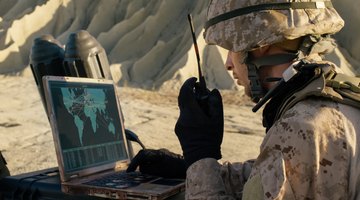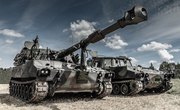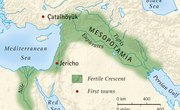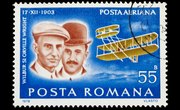In August 2019, President Donald Trump announced the reestablishment of the United States Space Command as an official part of the U.S. Department of Defense, leading up to what he described as a "Space Force" division of the U.S. military. Many see this as the beginning of the militarization of space, with new weapons and new technologies designed to protect and attack satellites in orbit.
Those with an interest in history would not be surprised by this. In 2007, the Chinese had shot down one of their own satellites, which could be interpreted as a demonstration of their military's technological capabilities. Back in 1985, Ronald Reagan had previously set up a U.S. Space Command, which was later merged into the U.S. Strategic Command following the terrorist attacks of September 11, 2001.
The promise or threat of using space technology as a method of gaining the upper hand in military operations is only the latest in a series of innovations that goes back at least 400,000 years, when the first stone-tipped spear was thrown.
Technology Improvements vs. Technological Breakthroughs
While military leaders may long for a great technological breakthrough that would turn a war in their favor or eliminate the threat of war, such breakthroughs are actually quite rare. In most cases, it's incremental changes to existing technologies that give one side an edge over the other. The Roman empire, perhaps the greatest military power in history, knew this very well.
While they are well-known today for siege weapons, triremes, roads and the weapons used by their legions, the Romans didn't actually do as much inventing as they did borrow and improve upon the ideas of others. If one of their many enemies had a superior technology, the Romans had no qualms about stealing it, as was the case in their adoption and adaptation of the Carthage triremes in the First Punic War. The Romans also saw the benefits of roads used by the Persians and Egyptians for moving armies quickly from one place to another and improved upon the technology, constructing 29 major highways all radiating from the capital, with the empire interconnected by a total of 372 roads.
The same can be seen in modern times. The tank was originally developed in World War I but had almost no effect on the outcome of the war, and it took another 20 years for the tank to become a major force in the battlefield in World War II. Iron ships first appeared during the American Civil War and would change naval warfare forever, but when the Monitor and Merrimack met, the battle ended in a draw and had no effect on that war. The same can be said of the fighter jet and the modern rocket, both developed by the Germans before they lost World War II.
The Impact of Technology on Warfare
None of this is to say that superior technology isn't an important or even vital element for victory. However, it's almost always the incremental improvements that contribute to victory, combined with superior strategies, tactics and, of course, a country's economic production capabilities.
A classic example of this is the development of aircraft technology in the Pacific Theater of World War II. At the outset of the war in 1941, the Japanese Zero was vastly superior to the American's Hawker Hurricane or Curtiss P-40 Tomahawk. It could fly faster and higher and was more maneuverable than what the Americans had at the beginning of the war. However, as the war progressed, the Japanese could not keep up with the pace of innovation and amount of production by the United States, due in no small measure to the U.S.'s superior economic output.
Perhaps the greatest and most horrific technological breakthrough in military history was the invention of the atomic bomb. Most people believe that the atomic bomb forced the surrender of Japan, bringing an end to World War II. However, many historians recognize that this was not in fact what ended the war, and it was in all likelihood the massive invasion of the Soviet Red Army that led to Japan's surrender, which began the same day that Nagasaki was bombed.
Positive Effects of Military Technology on Society
Military technology advances frequently pave the way for advances that benefit society during periods of peace. Perhaps one of the most iconic examples can be found in the U.S. and Soviet space programs of the 1950s and 1960s. The same V2 rockets that Nazi Germany had used to terrorize London during World War II became the basis of both the U.S. and Soviet space programs.
Neil Armstrong would not have been the first man to land on the moon if it had not been for the V2 rocket technology. In fact, the chief architect of NASA's Apollo Saturn V rocket was Wernher von Braun, inventor of the V2.
- Ambulances were originally developed by the Spanish in 1487 as a way to get wounded soldiers away from the battleground quickly. Of course, they were not motorized back then.
- The internet is a direct descendant of the Advanced Research Projects Agency Network, which connected military and educational institutions.
- The GPS was originally developed by the U.S. Department of Defense.
- Duct tape was invented during World War II as a water-resistant way to seal ammunition cases.
- Weather radar evolved from radio detection and ranging technology developed during World War II.
- Microwave ovens also evolved from RADAR developments in World War II.
- Digital cameras came from technology used to capture high-resolution images from spy satellites.
- Computers as we know them today would not be possible if it weren't for Colossus, the first electronic computer, which was used to break Nazi encrypted messages.
- Jet engines were patented in 1930 but were not seriously developed until World War II. The first jet fighter was the German Messerschmitt Me 262, which came out in 1944.
- Synthetic rubber was developed during World War II due to a shortage of natural rubber.
- Though it wasn't released until 1958, super glue was invented as part of the war effort during World War II.
- Known today for combating severe allergic reactions, the EpiPen was developed as a way to treat soldiers in case of chemical warfare.
History of Military Technology Timeline
From prehistory to modern times, the timeline of military technological developments is an upward curve. Developments were very slow for the first several thousand years, accelerating quickly into the 20th century.
- 400,000 B.C.: The earliest evidence of humans using spears dates back to the Paleolithic Age, discovered near the town of Schöningen, Germany in 1994.
- 40,000 to 25,000 B.C.: The atlatl was the predecessor to the bow and arrow, which flung flexible darts at a distance of about 44 yards.
- 23,000 B.C.: The oldest boomerang was discovered in a cave in Poland and was made from mammoth tusk. Boomerangs were used throughout Europe and Africa.
- 20,000 B.C.: The earliest use of bows and arrows date to this time based on discoveries of arrowheads.
- 5300 B.C.: The first horses were domesticated on the steppes of Kazakhstan.
- 5000 B.C.: Bronze weapons appear, beginning with daggers and then swords.
- 1200 B.C.: The dawn of the Iron Age soon makes bronze weapons obsolete.
- 500 B.C.: Two artillery weapons appear. The trebuchet is developed in China, while the Greeks develop the ballista.
- 1000: The Chinese invent gunpowder and, under the Song Dynasty, use it in warfare.
- 1260: Egyptian soldiers use hand cannons at the Battle of Ain Jalut.
- 1415: At the Battle of Agincourt, the outnumbered English defeat the French using longbows.
- 1368-1644: China's Ming Dynasty begins developing new gunpowder firearms, including matchlocks, muskets and naval mines.
- 1750: Rockets begin to appear on battlefields.
- 1775: American David Bushnell invents the first submarine to be used against British naval vessels.
- 1803: British troops begin using Shrapnel shells, invented by Henry Shrapnel.
- 1836: Samuel Colt patents his revolver.
- 1851: Appearance of the first machine gun, the multibarreled mitrailleuse, followed soon by the Gatling gun.
- 1862: The first iron-clad warship, the USS monitor, appears in the U.S. Civil War.
- 1914: The British introduce the first tanks to the battlefields of World War I.
- 1945: The first atomic bomb is tested in New Mexico in July. In August, bombs are dropped on Hiroshima and Nagasaki.
- 1952: The first hydrogen bomb is detonated in the Marshall Islands. Instead of fission, the hydrogen bomb uses fusion, making it much more powerful.
- 1960: The laser is invented, which would later be used for missile targeting systems.
Advancements in Technology Compared to Strategies
Advancements in military technology have a major impact on military strategies. There could have been no blitzkrieg ("lightning war") at the dawn of World War II, for example, without the advancements the German Wehrmacht had made in its Panzer tanks, combined with its decision to place those tanks in separate units rather than keeping them behind to support the infantry, as had been the norm until 1939.
The development of rifled barrels and soft-lead minie balls during the American Civil War had horrendous consequences for troops on both sides of the battlefield. Not accustomed to these advanced weapons, military commanders continuously failed to adapt their strategies. The Battle of Gettysburg alone resulted in 28,063 Confederate casualties from an original force of 75,000 men and 23,049 Union casualties from an original force of 82,289 men. It was not until the war was nearly over that they adopted appropriate defensive strategies, including advanced fortifications and the use of trenches.
By 1914, weapons had continued to outpace strategies, particularly with improvements in machine guns and artillery and, to a slightly lesser degree, chemical warfare. At the outset of World War I, most had anticipated a fast conclusion after only a few months. Instead, the result was once again horrifically massive losses of life on both sides and a near stalemate in Western Europe's thousands of miles of trenches that lasted for nearly four years.
Military Technology as a Peacekeeper
So bloody had been World War I that it was believed for many years that nobody would want to fight another war again. The League of Nations was established to resolve conflicts peacefully and to make war obsolete. While this hope, like the League of Nations, lasted less than 20 years, World War II may have been the war to end all world wars due to the development of atomic weapons.
When both sides of a conflict have the ability to annihilate every human on the planet, the prospect of another world war would be, quite literally, insane. It should be no surprise that the United States and its nemesis the Soviet Union engaged in a Cold War instead, with hot wars limited to specific regions of the globe. For the most part, the Cold War was limited to technological bragging rights, as illustrated by the space race of the 1950s and 1960s.
Related Articles
References
- NewScientist: Timeline: Weapons Technology
- BBC Future: V2: The Nazi Rocket That Launched the Space Age
- Pocket-lint: 28 Ways Military Tech Changed Our Lives
- History Extra: Invention or Adaptation: What Did the Romans Really Do For Us?
- The National Interest: This Was Imperial Japan's Best World War II Fighter (America Feared It)
- CNET: Trump's Space Force: Everything You Need to Know
- Ancient History Encyclopedia: Carthaginian Naval Warfare
Writer Bio
A published author and professional speaker, David Weedmark has advised businesses and governments on technology, media and marketing for more than 20 years. He has taught computer science at Algonquin College, has started three successful businesses, and has written hundreds of articles for newspapers and magazines throughout Canada and the United States.











